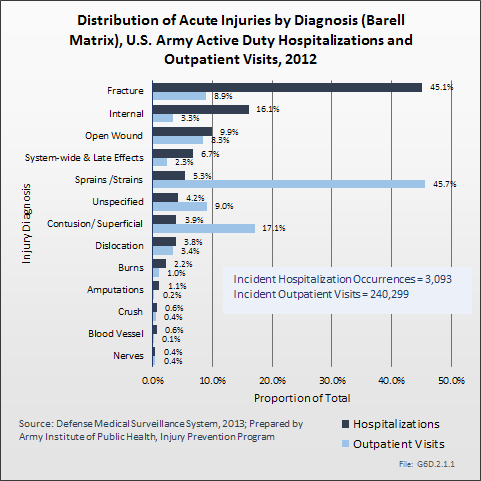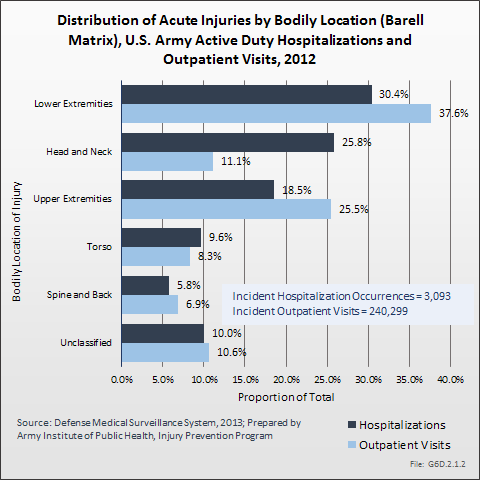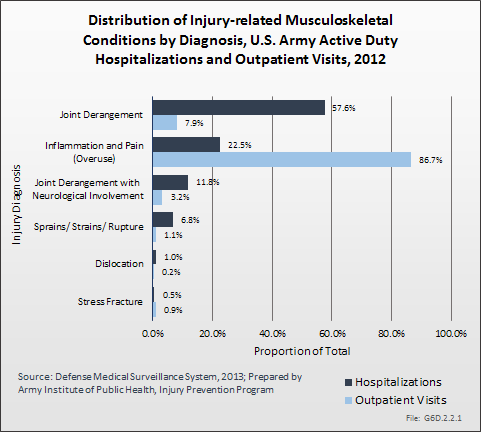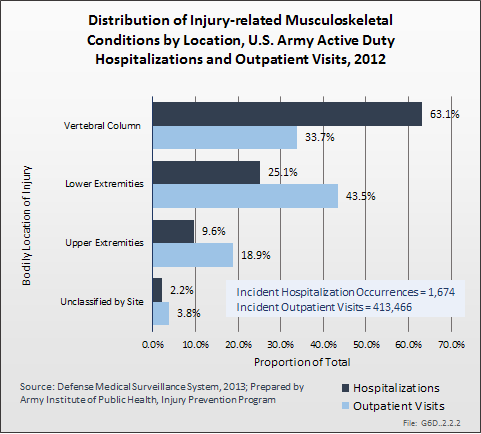

Acute injuries among active duty, nondeployed US Army soldiers are characterized by the types of injuries incurred, as well as the bodily site of the injuries. Two types of analytical injury matrices are available to further describe acute injuries and injury-related musculoskeletal conditions: (1) the Barell Injury Diagnosis matrix1 and (2) the injury-related musculoskeletal conditions matrix.2 Matrices report ICD-9-CM code frequencies by type of injury and body region. (Reference Table 6D.1 PDF [1] CSV [2] and Table 6D.2 PDF [3] CSV [4])
In 2012, there were 3,093 acute traumatic injuries (coded in the 800–900 ICD-9-CM code series) requiring hospitalization. Leading specific reasons for hospitalizations included fractures of the lower leg and/or ankle (13 %), facial fracture (6%), and fracture of the foot/toes (3%). Comparing all body regions, the lower extremity accounted for 30%, the upper extremity for 19%, and the head for 16%. Within the head region, traumatic brain injury, including skull fracture, accounted for 15%, and other specified head injuries accounted for less than 1%. (Reference Table 6D.1 PDF [1] CSV [2])
During the same year, US Army active duty, nondeployed soldiers incurred 240,299 acute traumatic injuries (coded in the 800–900 ICD-9-CM code series) for which outpatient care was required. Leading specific reasons for outpatient visits included strains/sprains to the lower leg and/or ankle (9%) and strains/sprains of the shoulder/upper arm (7%). Body regions most affected were lower extremities (38%), upper extremities (26%), and the head and neck region (TBI and other head, face, and neck) (11%). (Reference Table 6D.2 PDF [3] CSV [4])

In 2012, there were 1,674 hospitalizations due to injury-related musculoskeletal conditions, roughly one-half the number of acute traumatic injuries requiring hospitalization. The most common types of injury-related musculoskeletal conditions leading to hospital admission were joint derangement (58%), followed by inflammation and pain due to overuse (23%). Joint derangement with neurological involvement accounted for another 12%. The vertebral column (including spine/back) was the most affected by injury-related musculoskeletal conditions (63%), followed by lower extremities (25%) and upper extremities (10%). (Reference Table 6D.3 PDF [5] CSV [6])
There was nearly twice the number of injury-related musculoskeletal conditions requiring outpatient visits as there were acute traumatic injuries. In 2012, there were a total of 413,466 outpatient visits for injury-related musculoskeletal conditions (710–739 ICD-9-CM series). Most outpatient visits for injury-related musculoskeletal conditions involved inflammation and pain due to overuse (87%). Lower extremities (44%) was the body region most often treated on an outpatient basis, followed by the vertebral column (including spine/back) at (34%), and upper extremities at 19%. The leading specific injury-related musculoskeletal conditions requiring outpatient treatment were inflammation and pain (overuse) to the knee and/or lower leg (20%), inflammation and pain (overuse) to the lumbar spine (18%), inflammation and pain (overuse) to the ankle and/or foot (14%), and inflammation and pain (overuse) to the shoulder (12%). (Reference Table 6D.4 PDF [7] CSV [8])

Links:
[1] https://bmus.latticegroup.com/docs/T6D.1.pdf
[2] https://bmus.latticegroup.com/docs/T6D.1.csv
[3] https://bmus.latticegroup.com/docs/T6D.2.pdf
[4] https://bmus.latticegroup.com/docs/T6D.2.csv
[5] https://bmus.latticegroup.com/docs/T6D.3.pdf
[6] https://bmus.latticegroup.com/docs/T6D.3.csv
[7] https://bmus.latticegroup.com/docs/T6D.4.pdf
[8] https://bmus.latticegroup.com/docs/T6D.4.csv